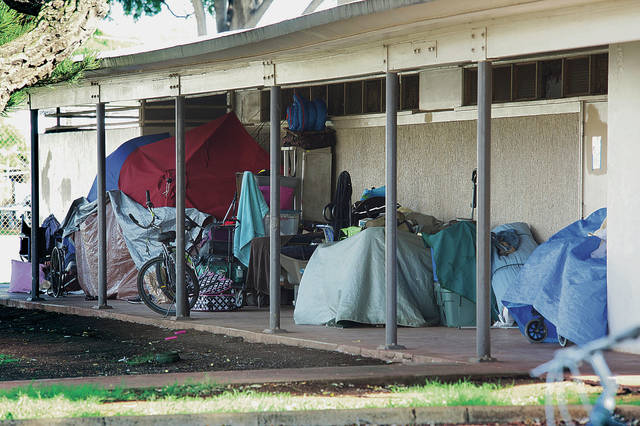Report shows drop in homeless numbers

CRAIG T. KOJIMA / CKOJIMA@STARADVERTISER.COM
Hawaii in 2017 was one of three states with chronically homeless populations above 30 percent, according to a report by the U.S. Department of Housing and Urban Development. The other two states were New Mexico and California. Tents surrounded the restroom areas of Crane Park on Aug. 31.
A new report that looks at homelessness in America in 2017 underscores the progress Hawaii has made in the last two years, when the state’s overall homeless rate has consecutively dropped 9 percent.
As social service agencies across the islands recruit volunteers to help determine the number of homeless people in their communities for the so-called Point in Time count in January, the U.S. Department of Housing and Urban Development said in a report to Congress on Monday that Hawaii was still struggling to turn around its numbers in 2017.
In 2017 Hawaii — with a 19 percent gain — also was one of five states that saw the biggest increases in its homeless populations between 2007 and 2017. And Honolulu — with 4,959 homeless people — led all “smaller” cities and counties by raw numbers in 2017.
California had the largest number of homeless people — by state — with a 2017 count of 134,278 homeless people, followed by New York (89,503), Florida (32,190), Texas (23,458) and Washington (21,112), according to the HUD report.
California in 2017 accounted for 31 percent of America’s overall homeless population.
Hawaii was among four states that year — including California (68 percent), Nevada (58 percent) and Oregon (57 percent) — where more than half its homeless people (53 percent in Hawaii) lived “unsheltered.”
Don't miss out on what's happening!
Stay in touch with breaking news, as it happens, conveniently in your email inbox. It's FREE!
Even though their sizes are dramatically different, Hawaii tied California in having 82 percent of its homeless youth living unsheltered. Nevada led all states with 89 percent of its homeless youth being unsheltered in 2017.
In 2017 Hawaii also was one of three states with chronically homeless populations above 30 percent. They were New Mexico (38 percent), Hawaii (35 percent) and California (32 percent.)
Hawaii in 2017 was among three states where more than half of all homeless military veterans (62 percent in Hawaii) lived unsheltered. The other two states were California (67 percent) and Oregon (53 percent).
Hawaii also was one of five states that saw its number of homeless veterans increase between 2009 and 2017. With 116 more homeless veterans, Hawaii trailed only Washington, which counted 130 more veterans in 2017.
Although Hawaii still has the highest per capita homeless rate in the country, the Point in Time Count saw back-to-back, statewide reductions of homeless people of about 9 percent that began in 2017 and were repeated in 2018.
At the same time, in 2017, the rest of the country saw the overall number of homeless people increase for the first time in seven years — by less than 1 percent.
That meant that 553,742 people — or 17 out of every 10,000 — were counted as homeless in January 2017.
HUD said the number of unsheltered homeless people in America’s biggest cities drove the nearly 1 percent increase in 2017.
While some mainland communities conduct their Point in Time Counts on a specific night in January, Hawaii’s January Point in Time Count lasts nearly a week on each island to get as thorough a count as possible.
In 2017 the number of people homeless in Hawaii dropped for the first time in eight years. The reduction meant that overall island homelessness fell 9 percent, for a total homeless population of 7,220 people. Oahu was the only island that saw its number of homeless people increase in 2017, by 19 people.
This year the number of homeless people again fell across all islands by a total of almost 10 percent, bringing Hawaii’s statewide homeless population to 6,530 people.
———
To view the entire report, visit bit.ly/2kthLvp.



